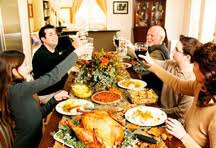Every fall, dieters, amateur nutritionists and healthy eaters everywhere start putting together a battle plan for surviving the holiday onslaught of great-tasting but bad-for-you foods. From work related potlucks to family suppers with all the traditional fixings, watching fat, sugar, sodium, cholesterol and alcohol around the holidays can be a major challenge.
According to The New England Journal of Medicine, every year the average American gains more than a pound (0.48-kg) of holiday weight [source: NEJM]. The good news is that this is less than you might have thought after listening to those diet-related ads on television. The bad news may be a little more alarming, though. That pound you do gain doesn't melt away when you start taking advantage of your gym privileges in January. It hangs around for the duration, and next year you add another pound, and another the year after that.
The accumulated weight of years of holiday indulgence may be doing more than affecting your slender silhouette. Increased weight and nutritional mismanagement may be putting you at risk for heart disease, high blood pressure, high cholesterol, type 2 diabetes and a host of other maladies.
Know Which Food Is Your Greatest Weakness
It's hard to pick a single major offender in the holiday competition for the worst-for-you food. After all, well meaning mothers and grandmothers everywhere start stockpiling butter in September so they'll have enough for their (insert your favorite childhood holiday indulgence here). Everybody has one. It may be a cookie crammed full of butter, nuts and sugar, or ham dripping with maple syrup. The holidays are about bounty, and holiday dishes take that philosophy to heart. Back when the average American ate smaller servings and did more physical labor, it wasn't as big a problem. Nowadays, you might be wearing that yummy favorite on your backside for the next decade or longer.
Since folks are more aware of nutrition than they used to be, some of the biggest offenders, such as deep-dish pies, stuffing dripping with meat juices and butter and fatty meats, set off automatic warning bells. But what about those sneaky offerings that you may not even think of as food?
The Big Bad
How about eggnog? A commercially available brand of eggnog could easily contain more than half of your daily allotment of saturated fat (19 grams) and cholesterol (150 milligrams) and 21 grams of sugar or more in an eight ounce glass (236.5 milliliter). That doesn't include the whipped cream on top or that liberal jiggerful of brandy or rum. This is just for prepared eggnog. Your Uncle Joe's version may be even worse. If you indulge in a glass before you hit the buffet, you just derailed any plan you had in mind for eating a halfway prudent holiday meal, and dinner hasn't even started yet.
Cream or butter based beverages that contain loads of fat and sugar can be nutrition busters without you even realizing it, and that's what makes them so dangerous. At least with decadent desserts, you have some advanced warning.


















